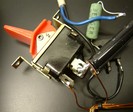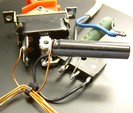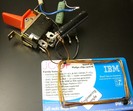RFID Zapper
Because a previous attempt at frying an RFID chip was unsuccessful, the original RFID Zapper idea was embraced anew. The alternative methods, subjecting the chip to a strong field from an industrial heater running at 13.56 MHz just heated the chip thus creating a very suspect bubble in the plastic. The microwave method, the other contender, was not tried but this has the tendency of setting stuff on fire.
What is an RFID Zapper? The original idea used the flash unit of a disposable camera to generate a strong EMP (ElectroMagnetic Pulse) with a coil connected across the flash capacitor. I wanted to do the same only the source for my flash circuit, a FujiFilm F401 digicam, proved way too complicated to attempt to use the voltage converter to charge the flash capacitor. Instead I resorted to the good old line voltage, here in Europe a shocking 230 V. The digicam provided the flash capacitor, which was 60 µF at 320 V. Some more parts were scrounged from the junk box, all from a discarded AT-type computer power supply. The most important component was the Big Red Switch, with both contacts connected in parallel to be able to handle the hefty discharge current of the flash capacitor. This proved a necessity as another switch was rendered useless because its contacts were welded together... The mains rectifier is used to convert the AC line voltage to DC. A final component, the current limiting resistor (2.2k/4W, not critical), was also added. This will prevent the capacitor being damaged by the rush-in current and also protect the (unfused!) circuit. The coil, a rectangular affair of 4 by 6 cm, 5 turns and made of 0.5 mm enamel copper wire, was already available from a previous experiment.
After hooking everything up it was time to try it. I had two cards at my disposal which I first tested for RFID functionality using my RFID Card Detector. Then a card was placed under the coil, the capacitor charged for a few seconds and then the switch was thrown. A resounding <CLACK> was heard, but that was it. The RFID Detector proved that the card was rendered inoperative. The second card was also submitted to the BRS treatment, and it did not survive either. Unfortunately I could not test the Dutch Ausweis... euh... ID card but this is only a matter of time.
A word of caution: this circuit is live! This means it is connected to the line voltage which kan kill you! The best way to use it is to plug it into the mains for a few seconds, disconnect and then throw the BRS. Be careful not to touch anything as the flash capacitor will be charged to 300 V before zapping.
Happy zapping!
 rfid-zapper-schematic |
 rfid-zapper0 |
 rfid-zapper1 |
 rfid-zapper2 |
 rfid-zapper3 |